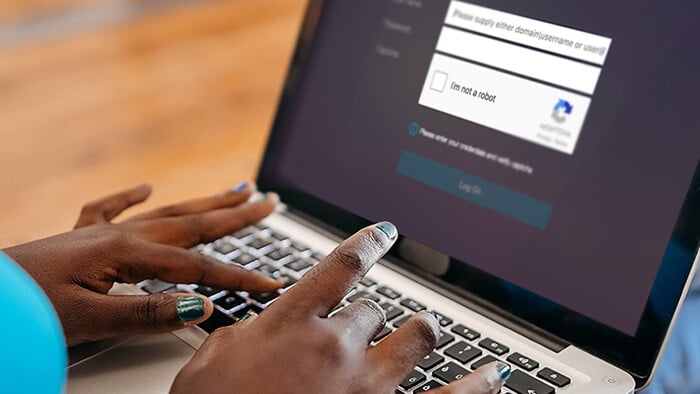- Security
- Privacy
- Performance
The websites you visit every day aren't all there is to see on the internet — not even close. Beyond this “surface web” is the deep web, and within the deep web is the dark web. Find out what the dark web is and how you can access it. Then, use data breach monitoring software to help find out if your personal data has leaked onto the dark web.

The dark web refers to content on the internet that is intentionally hidden and requires special software like Tor Browser to access. The dark web is a subset of the deep web, which is all content on the internet that isn't indexed by search engines.
The hidden nature of the dark web has earned it the nicknames black web and underground internet. However, these names likely conjure up a scarier conception than the real definition of the dark web.
The dark internet is designed to provide anonymity by keeping communication private through encryption and routing online content through multiple web servers. While the dark web is often depicted as an anarchic forum for criminal activity, that’s not necessarily true. The darknet is simply an anonymous space on the web that can be abused or appreciated in turn.
The difference between the dark web and the deep web is that the deep web refers to websites and web pages that aren’t indexed by search engines, like login pages and payment portals. The dark web, by contrast, is configured on darknets — online networks that can be accessed only with special software and techniques.
Deep web websites are the pages behind paywalls, authentication forms, logins, and passwords. Much of the online content you access every day is part of the deep web: your email, online banking accounts, private social media accounts, and subscription services. You wouldn’t want your email history available on the surface web and searchable by anyone.
The dark web is also part of the deep web — but it’s built on darknets: overlay networks that sit on the internet but can’t be accessed without special tools or software like Tor. Tor is an anonymizing software tool that stands for The Onion Router, and you can use the Tor network via Tor Browser.
Unlike typical web browsers, Tor Browser uses onion routing, which encrypts and routes traffic through multiple servers around the world to hide your IP address and provide private browsing. In addition, all domains on the Tor network end with the top-level domain .onion (instead of .com). The many layers of an onion represent the multiple layers of encryption in the Tor network.

The dark web may seem large, but it’s actually not. Researchers from Recorded Future estimated that while there are more than 55,000 existing onion domains, only 8,400 (or roughly 15%) of these sites were active. So, when measuring the total network of live dark web sites alongside the surface web, only about 0.005% of the internet is the dark web.
Dark web domains tend to be inconsistent — new ones pop up and others disappear, which makes sense if they offer questionable or illegal goods and services.
The Tor Project says that of the 2 million people using Tor every day, only 1.5% of them are accessing hidden or dark websites (that’s 30,000 people). Most dark web websites are in English; according to one estimate, a staggering 78% of information on the dark web is in English.
The quickest way to access the dark web is to download and install Tor Browser, which will route your traffic through the Tor network and let you access the dark web. On Tor, you can type in any URL you’d like to visit, including .onion links on the dark web.

Tor is a web browser that lets you stay anonymous online or access the dark web. Tor shares similarities with VPNs and proxy servers — all of these tools allow anonymous browsing. Tor can be used together with a VPN to provide overlapping layers of privacy and anonymity.
The Tor network combined with a VPN is one of the safest ways to get on the dark web. This is a practice known as Tor-over-VPN. Many internet service providers (ISPs) and governments are suspicious of Tor use, but a VPN will hide your internet activity and help prevent anyone from knowing that you’re using Tor.
Here are the steps to take to get on the dark web:
Connect to a reliable and safe VPN.
Conceal your IP address and encrypt your internet connection with a trustworthy VPN like Avast SecureLine VPN. Though they both provide encryption, a VPN and Tor are not the same thing. A VPN will prevent your ISP and anyone else from knowing that you're downloading and using Tor Browser. It’ll also help hide all your other online activity.
Download and install Tor Browser.
Tor Browser is a free browser that routes your traffic through the encrypted Tor network and allows you to access the dark web. Download Tor Browser only from the official Tor Project website, because unlicensed third-party downloads may come bundled with malware.
Browse the dark web with Tor Browser.
Tor Browser will let you access the .onion links of the dark web. Because the black web is largely unregulated, never visit dark websites without first confirming their authenticity.
Before accessing the dark web, install strong security software to help keep your device protected.

You can access the dark web on mobile with a dedicated dark web browser app. Install a mobile dark web browsing app — like Tor browser for Android or the Onion browser for iPhone — and enter an onion URL to start browsing.
As always, protect yourself from online threats with mobile Android security or iOS security software. And use a VPN for Android or a VPN for iOSto get a secure, private connection.
Dark web browsing is not as simple as regular web surfing, but there are some tools you can use to chart your journey. Dark web search engines and forums like Reddit can help you find reliable dark websites, and you’ll need to use a dark web browser to visit them.
The standard dark web browser is Tor Browser, which directs your browser traffic through the Tor network so you can reach the darknet. As your traffic passes through Tor, it’s encrypted and bounced between at least three relay points, known as nodes. This helps obscure the origin of the data (and makes it hard for anyone to find your IP address). But as a result, Tor Browser will feel much slower than a normal web browser.
Surface web search engines can’t access the darknet, but specialized dark web search engines can help you find what you’re looking for. DuckDuckGo is a popular privacy-focused search engine that doesn’t track you across the web. DuckDuckGo’s dark web search engine may index pages on the dark web, but you’ll need to open it with Tor Browser.
Other dark web search engines include Not Evil, Torch, Haystack, and Ahmia. The subreddit r/deepweb is a good starting point for asking more experienced users about how to search the dark web and deep web for the content you want. Lastly, The Hidden Wiki is a collection of dark web links — but the links may not work and can lead to dangerous websites.
Dark websites can be visited only with a suitable dark web browser, and most dark web URLs are strings of seemingly random letters and numbers — nothing like the easy-to-remember web addresses on the surface web.
The Hidden Wiki is a surface website offering a collection of dark web links. Before visiting any dark websites, get comprehensive cybersecurity software to help protect yourself from threats you may encounter.
Here are some of the kinds of websites you can encounter on the black web:
Archives of paywalled scientific publications
News websites like BBC News and The New York Times
Social media sites like Facebook
P2P file sharing sites
Pages for anonymous whistleblowing
Torrenting sites
Dark web wikis
Crypto wallet services
Image hosting sites for illegal and disturbing material
Marketplaces for illegal goods and services
While some reports of dark web murder-to-order are overblown, it is possible to commission acts of cybercrime on the dark web. These range from phishing campaigns to DDoS (distributed denial of service) attacks, which can take down entire servers and websites.
Here are some of the types of cybercrime that can be purchased on the black web:
Malware development and distribution
Botnet management
Computer or network hacking
Keylogger installation
Refund scams
Sensitive information exfiltration
Phishing campaigns
Ransomware attacks
Email or social media account password cracking
Cyber espionage
As well as enlisting seasoned cybercriminals, inexperienced “green hats” and other types of hackers can even pay to access tutorials in the form of dark web videos and manuals to help them get started with making their own malware.
The dark web in and of itself is not illegal. The dark web limits online tracking, and there are many legitimate reasons people like journalists and activists use the dark web to remain private. But there are also many illegal activities that happen on the dark web. And just like in real life, using the dark web for criminal purposes is never legal.
If you use Tor to access the dark web or unblock websites, connect with a VPN for extra security. Because of the dark web’s association with illicit activity, your use of Tor may be tracked by your ISP, drawing unwanted scrutiny to your browsing behavior.
Yes, the dark web is used for many illegal activities. It’s possible to buy and sell illegal drugs, malware, and prohibited content in darknet marketplaces. Some dark web commerce sites have dangerous chemicals and weapons for sale.
Some hackers offer ransomware as a service (RaaS), where cybercriminals can “rent” a strain of ransomware from its creator in exchange for a fee or a percentage of their ransom payments. Others sell software exploits that other cybercriminals can use to infect victims with malware and steal personal data.
The most well-known dark web marketplace was the Silk Road, which launched in 2011 and essentially functioned as an Amazon-like market for illegal drugs. In 2013, the FBI shut down the Silk Road, and its founder Ross Ulbricht is now serving a double life sentence.
 Dark web marketplaces offer a variety of illegal goods for sale.
Dark web marketplaces offer a variety of illegal goods for sale.
Fraud and scams run rampant on the dark web, including offers too good to be true and fake services requiring upfront payment. Hackers sell access to email accounts, social media profiles, or other information that can be used for identity theft.
Avast BreachGuard helps to keep your data off the dark web. By monitoring known dark web marketplaces, Avast BreachGuard will alert you immediately if and when your data is found. That way, you can change your passwords and lock down your accounts to help block scammers from using your data against you.
Dark web marketplaces offer a range of both legal and illicit goods. Here’s a look at several of the illegal items you can buy — with prices — courtesy of Privacy Affairs’s Dark Web Price Index 2023.
The dark net is not quite as lucrative as it used to be and the prices for most of these items or services have gone down in recent years.

The dark web can certainly be dangerous — with no regulation, it’s a riskier place to hang out than the surface web. Malware and scams are scattered like landmines around the dark web. And with many unfamiliar-looking sites on the dark web, it’s harder to distinguish safe websites from shady ones, and easier to fall victim.
Regular dark web visitors know that it’s possible to exploit the sketchy reputation of the space and the services offered. And though some dark web marketplaces offer user reviews, not all do. Lack of regulation by authorities or other users makes it easy for cybercriminals to carry out scams.
Your information might be on the dark web if it was exposed in a data breach, sold, or stolen by hackers. To check, you can use dark web scanning or breach detection tools like Avast Hack Check or LifeLock Breach Detection to search for compromised data. If found, take immediate steps to secure your accounts and personal information.
|
Types of personal info commonly found on the dark web |
Dark web price |
|
Cloned Visa or MasterCard with PIN |
$20 |
|
Stolen online banking login, minimum balance of $2,000 |
$60 |
|
Hacked Coinbase account (verified) |
$250 |
|
Hacked Facebook account |
$25 |
|
Forged EU passport |
$3,000 |
When data brokers get hacked, the stolen data can include compromised credit cards, social security numbers, and other data, depending on what was exposed in the breach. This is a common way for identity theft and doxing attacks to occur. Cybersecurity teams comb through these breaches and incorporate their findings into their security software, helping people like you.
What should you do if your information is found in a data breach or you think it’s been leaked somewhere? Change your passwords and watch out for suspicious activity on your credit reports. Learn the ways to help prevent and fix identity theft. That’s really the best you can do.
It’s always better to have more awareness than none. Avast BreachGuard monitors the dark web for data breaches around the clock. If a breach is detected, BreachGuard will notify you right away and help you take the steps you need to secure your data immediately.
It’s very difficult to track online activity on the dark web. When you use Tor, which routes your internet traffic through many different relay nodes, your online activity is obscured because you’re browsing anonymously. Tor also supports various privacy extensions.
That doesn't mean it’s impossible to track users on the dark web. If you log into personal accounts on the dark web or visit websites with tracking scripts, then your activity may be tracked. Similarly, unless you’re using a VPN, your IP address will be visible to the first relay node you connect to.
If you decide to venture into the dark web, follow these tips to help keep yourself safer:
Use burner accounts. Avoid using any username, email, or password similar to those on your regular accounts.
Don’t use an admin account. Use a local account with many permissions restricted to prevent malware from gaining easy access to your system.
Use strong antivirus software. The best internet security software will help detect and block security threats in real time.
Use a VPN. Onion routing conceals your online activity, but the initial network you connect to can still see your IP address. To prevent this, use a VPN to mask your IP address, adding an extra layer of anonymity.
Be wary of downloads. Downloads on the dark web are unlikely to be safe — approach everything with skepticism.
Don’t purchase anything. It’s not advisable to buy anything on the dark web. Many transactions are scams, and even if they seem legitimate, there are significant risks of losing your money or exposing sensitive information.
Configure Tor. Customize your Tor settings for maximum privacy. Disable JavaScript, ActiveX, and Flash plugins, even if it might break the functionality of some dark web sites.
The beginning of the dark web is generally seen as coinciding with the release of Freenet in 2000. As the thesis project of Ian Clarke, a student at the University of Edinburgh in Scotland, the Freenet was built to help people anonymously communicate, exchange files, and interact online.
In 2002, the dark web grew significantly when researchers supported by the US Naval Research Laboratory built and released the Tor network. At the time, the internet was still young, and tracking people was easy while staying anonymous was not. The Tor network allowed safe communication channels for political dissidents and American intelligence operatives around the world.
Later, Tor’s underlying code was released under a free license, and a nonprofit called the Tor Project was formed. In 2008, the Tor Browser was released, which made it easy for anyone to get on the darknet. The existence of an anonymous and hidden internet then allowed for alternative information channels and illegal websites to flourish.
Data breaches happen all the time, and your login credentials and other data might be on the dark web already. Avast BreachGuard scans the dark web and will alert you immediately if and when it detects your personal data. BreachGuard will guide you through the process of recovering your accounts, helping you lock them down before a hacker can use your leaked credentials. Secure your data with a specialized dark web monitoring tool.
Get Avast BreachGuard for PC to protect your privacy and keep your personal data from falling into the wrong hands.
Get it for Mac
Get Avast BreachGuard for Mac to protect your privacy and keep your personal data from falling into the wrong hands.
Get it for PC
Install Avast SecureLine VPN for Android to protect your privacy and keep your data from falling into the wrong hands.
Install Avast SecureLine VPN for iOS to protect your privacy and keep your data from falling into the wrong hands.












Connect privately on your Android with Avast SecureLine VPN
Avast
SecureLine VPN
Connect privately on your iPhone with Avast SecureLine VPN
Avast
SecureLine VPN